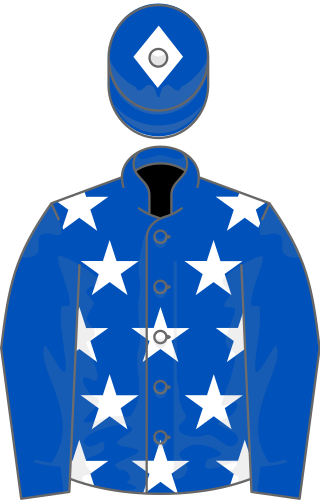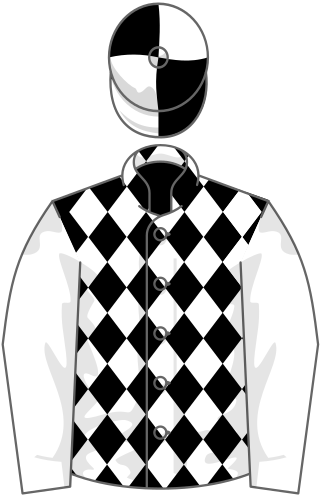Related Research Articles

Teenoso was an American-bred, British-trained Thoroughbred racehorse. After showing moderate form as a two-year-old, he improved in the spring of 1983 to win the Group Three Lingfield Derby Trial and the Epsom Derby, giving Lester Piggott a record ninth win in the Classic race. Teenoso was beaten in his two remaining races that year but showed good form as a four-year-old, winning the Ormonde Stakes, the Grand Prix de Saint-Cloud and, on his final appearance, the King George VI and Queen Elizabeth Stakes. He proved to be a disappointment at stud.
Pebbles was a British-bred Thoroughbred racehorse. In a racing career which lasted from 1983 until 1985, she ran fifteen times and won eight races. After showing good form as a two-year-old in 1983, she won the 1000 Guineas as a three-year-old the next spring. In 1985 Pebbles produced her most notable performances, becoming the first filly to win the Eclipse Stakes and then defeating an exceptionally strong field in the Champion Stakes. On her final racecourse appearance she became the first British-trained racehorse to win a Breeders' Cup race, when she won the Breeders' Cup Turf. She is regarded as one of the greatest fillies of the modern era.

Time Charter was an Irish-bred, British-trained Thoroughbred racehorse and broodmare who won several major middle-distance races between 1982 and 1984. After winning twice as a two-year-old in 1981, she developed into a classic filly in the following year, finishing second in the 1000 Guineas before winning The Oaks in record time. Later that year she won the Sun Chariot Stakes before beating a field of colts and older horses by seven lengths in the Champion Stakes. As a four-year-old she won England's premier weight-for-age race, the King George VI and Queen Elizabeth Stakes and successfully conceded seven pounds to the outstanding French filly All Along in the Prix Foy. In 1984 she recorded an impressive four length victory in the Coronation Cup and was retired from racing at the end of the year having won nine of her twenty races. She later became a very successful broodmare.

Sun Princess (1980–2001), was an Irish-bred British-trained Thoroughbred racehorse and Broodmare. In a career which lasted from September 1982 until October 1984, she ran ten times and won three races. She recorded all her successes at Group One level when a three-year-old in 1983 winning the Classic Epsom Oaks by a record margin of twelve lengths and the Yorkshire Oaks against other females before defeating colts in the St. Leger Stakes. In the same season she was placed in Europe's two most prestigious all-aged races, finishing third in the King George VI and Queen Elizabeth Stakes and second in the Prix de l'Arc de Triomphe. She raced without winning in 1984 before she was retired to stud, where she became the dam of several winners including the Dewhurst Stakes winner Prince of Dance.

Mysterious (1970–1988) was a British Thoroughbred racehorse. In a racing career lasting from July 1972 until October 1973 she ran eight times and won five races. Mysterious won Group races on her first four racecourse appearances including the Classic 1000 Guineas at Newmarket Racecourse and Oaks at Epsom. She later finished second to Dahlia in the Irish Oaks at the Curragh and won the Yorkshire Oaks at York.

Lupe (1967–1989) was a British Thoroughbred racehorse. In a racing career lasting from September 1969 until July 1971, the filly ran seven times and won six races. As a three-year-old she won the Oaks at Epsom and the Yorkshire Oaks at York before sustaining her only defeat in the Prix Vermeille. Lupe returned as a four-year-old and defeated colts to win the Coronation Cup and the Princess of Wales's Stakes. She was then retired from racing and became a successful broodmare.

Lady Carla was a British Thoroughbred racehorse and broodmare best known for winning The Oaks in 1996. In a racing career which lasted from October 1995 to July 1997 the filly ran six times and won three races. After winning her only race as a two-year-old, Lady Carla won the Listed Oaks Trial Stakes at Lingfield Park on her three-year-old debut. Four weeks later she maintained her unbeaten run in the Classic Oaks over 1+1⁄2 miles at Epsom, winning by nine lengths. She was beaten when favourite for the Irish Oaks and finished unplaced in two races the following season before being retired to stud.
Cormorant Wood was a British Thoroughbred racehorse and broodmare. She showed useful form in the early part of her career but developed into a top-class runner in the second half of her three-year-old season, winning the Sun Chariot Stakes and Champion Stakes at Newmarket Racecourse in October 1983. Her four-year-old season was curtailed by injury, but she became the first filly to win the Lockinge Stakes and produced her best performance in her final race when she won the Benson and Hedges Gold Cup at York Racecourse. At the end of the year she was the highest-rated female racehorse trained in Europe. Cormorant Wood was retired to stud where she had some success as a producer of winners.

Awaasif was a Canadian-bred, British-trained Thoroughbred racehorse and broodmare. After winning once as a two-year-old in 1981, she emerged as a top-class middle-distance runner in the following season, when she was officially the best British three-year-old of either sex. She showed useful form in the early part of the season and finished fourth in the Oaks Stakes. After recovering from illness she defeated a strong field in the Yorkshire Oaks and then ran a close third in the Prix de l'Arc de Triomphe. As a four-year-old she overcame training problems to record an impressive win in the Gran Premio del Jockey Club. As a broodmare she produced several winners, most notable Snow Bride, who won the Oaks and was herself the dam of the undefeated Epsom Derby winner Lammtarra.

Glint of Gold was a British Thoroughbred racehorse and sire. A middle-distance specialist, he was noted for his toughness and consistency, winning ten races, finishing second six times and third once in a seventeen race career which lasted from July 1980 until September 1982. He won races in four countries including six at Group One level. His major victories included the Gran Criterium and Derby Italiano in Italy, the Grand Prix de Paris and Grand Prix de Saint-Cloud in France, the Preis von Europa and Grosser Preis von Baden in Germany and the Great Voltigeur Stakes and John Porter Stakes in Britain. He was also placed in The Derby, St Leger Stakes, Coronation Cup and King George VI and Queen Elizabeth Stakes. He was retired to stud at the end of the 1982 season and had modest success as a sire of winners.

Diamond Shoal was a British Thoroughbred racehorse and sire. He showed some promise as a two-year-old, winning two of his six races. In the following year he won only one minor race but was placed in several major races, including a third-place finish in the St Leger Stakes. In 1983, Diamond Shoal emerged as a leading middle-distance performer, winning the John Porter Stakes in England, the Grand Prix d'Evry and Grand Prix de Saint-Cloud in France, the Gran Premio di Milano in Italy and the Grosser Preis von Baden in Germany. He was widely regarded as the best older male racehorse in Europe in 1983. He was retired to stud at the end of the year but had little success as a sire of winners.
Fairy Footsteps was a British Thoroughbred racehorse and broodmare best known for winning the classic 1000 Guineas in 1981. She showed promise in her first two races as a two-year-old before establishing herself as one of the best fillies of her generation with an emphatic win in the Waterford Candelabra Stakes. In the spring of 1981 she was heavily backed for the 1000 Guineas before and after a win in the Nell Gwyn Stakes. She won the 1000 Guineas by leading all the way and was considered highly likely to follow up with a win in the Epsom Oaks but was retired after a disappointing defeat in the Musidora Stakes. She had some success as a broodmare.

Fair Salinia was a British Thoroughbred racehorse and broodmare best known for winning the classic Oaks Stakes in 1978. In a racing career which lasted from September 1977 until September 1978 she won four of her eight races. As a two-year-old in 1977 she won on her debut before finishing second in the Cheveley Park Stakes. As a three-year-old she finished second in the 1000 Guineas before being moved up in distance and winning the Oaks, Irish Oaks and Yorkshire Oaks. She was retired to stud at the end of the season and had some influence as a broodmare. She died in 2004 at the age of twenty-nine.
Connaught Bridge was an Irish-bred Thoroughbred racehorse. Trained in the United Kingdom by Henry Cecil she raced for two seasons, winning five of her nine races. As a two-year-old she showed some promise, winning twice from five attempts. In the following year she did not run competitively until July, but after finishing third on her seasonal debut she established herself as one of the best middle-distance in Britain by winning the Nassau Stakes, Yorkshire Oaks and Twickenham Stakes. She was retired from racing at the end of 1979 and has had some influence as a broodmare.
Sarah Siddons was a French-bred, Irish-trained Thoroughbred racehorse. She was a well-bred mare, being descended from a half-sister of the outstanding Irish racehorse Ragusa. As a two-year-old in 1975 she showed promise when winning her only race of the season. In the following year she was rated the best three-year-old filly trained in the British Isles in a division which was otherwise dominated by French-trained horses. She recorded Group One wins in the Irish 1,000 Guineas and Yorkshire Oaks, as well as finishing second to Lagunette in both the Irish Oaks and the Prix Vermeille. She failed to win as a four-year-old, but became a very successful broodmare.
Godetia was an American-bred thoroughbred racehorse and broodmare who won two Irish Classic Races in 1979. Bred in Virginia, she was sold as a yearling and sent to race in Europe. As a two-year-old she showed promise when finishing second on her debut before winning her next race by twelve lengths. In 1979 she was unbeaten in four races in Ireland, taking the Athasi Stakes, Irish 1,000 Guineas, Pretty Polly Stakes and Irish Oaks, but ran poorly when sent to England for The Oaks and Yorkshire Oaks. She returned to race in the United States as a four-year-old but failed to make any impact in three races. As a broodmare she had some success but produced no major winners.
Pure Grain was a British Thoroughbred racehorse and broodmare. In 1994 she won two of her five races including the Prestige Stakes as well as finishing third in the Princess Margaret Stakes and fourth when favourite for the Fillies' Mile. In the following year she emerged as one of the best middle distance fillies of her generation in Europe with wins in the Musidora Stakes, Irish Oaks and Yorkshire Oaks. She also finished third in The Oaks and fifth in the Prix de l'Arc de Triomphe. After her retirement from racing she had some success as a dam of winners.

Give Thanks was a British-bred, Irish-trained Thoroughbred racehorse and broodmare. After showing little ability as a juvenile she emerged as a leading performer over middle distances in 1983. She won six of her first seven races including the Lingfield Oaks Trial, Musidora Stakes, Lancashire Oaks and Irish Oaks. She was also placed in the Yorkshire Oaks, Park Hill Stakes and Gallinule Stakes and ended the year rated the best filly of her generation in Ireland. After her retirement from racing she had some success as a broodmare, being the dam of the Falmouth Stakes winner Alshakr, and the grand-dam of Harayir.
Princess Pati was an Irish Thoroughbred racehorse and broodmare. After showing promise when finishing third on her only start as a two-year-old in 1983 she improved in the following year to become the best filly of her generation in Ireland. With the implementation of front-running tactics she won four races including the Pretty Polly Stakes and the Irish Oaks as well as finishing third in the Irish Champion Stakes. She failed to reproduce her best form in 1985 and was retired from racing at the end of the year. As a broodmare she produced winners, the best of whom was the Cambridgeshire Handicap winner Pasternak.
Eurobird was an Irish Thoroughbred racehorse and broodmare. A specialist stayer who was well-suited by soft or heavy ground, she was the third Classic race winner produced by the broodmare Irish Bird. As a three-year-old in 1987 she made steady improvement, winning the Kinderhill Oaks Trial, Blandford Stakes and Irish St. Leger by wide margins as well as finishing third in the Irish Oaks. At the end of the year she was rated the best filly in Europe over fourteen furlongs and further. She failed to win as a four-year-old but ran several good races in defeat. She later had considerable success as a broodmare, being the dam of at least ten winners.
References
- 1 2 Timeform staff (1984). Racehorses of 1983. Timeform. ISBN 0-900599-40-5.